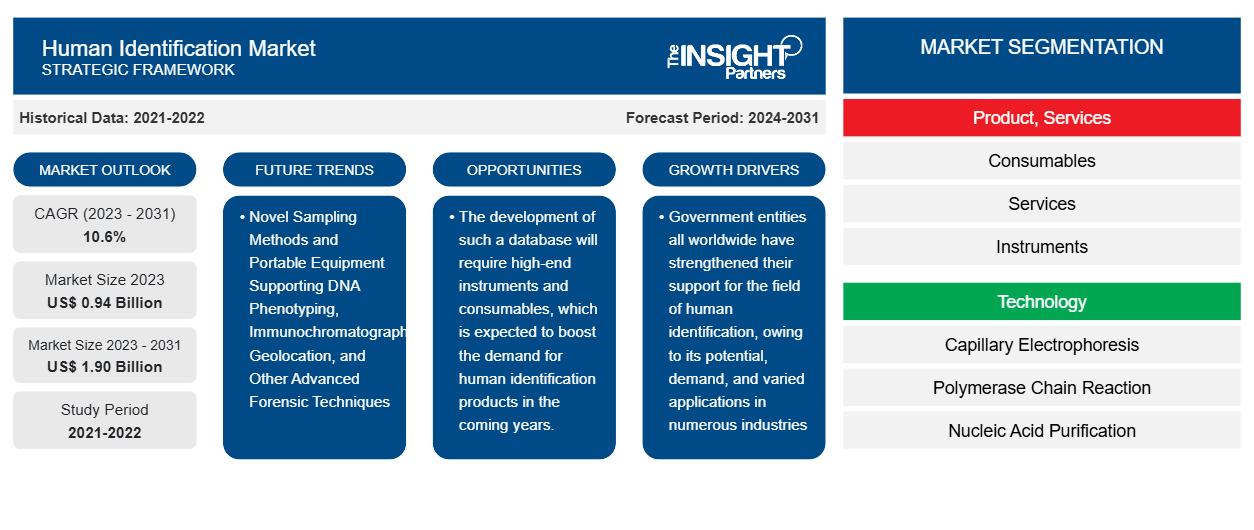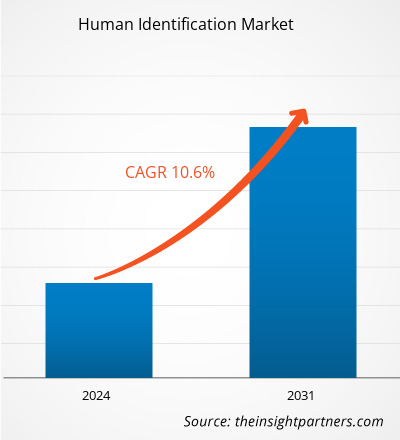The Vitrectomy devices market size is projected to reach US$ 1.90 billion by 2031 from US$ 0.94 billion in 2023. The market is expected to register a CAGR of 10.6% during 2023–2031. The growing intervention of technology in forensic science is likely to remain a key trend in the market.
Human Identification Market Analysis
Increased government funding for forensic science in the region and expansion of the US DNA database is projected to accelerate the growth of the market. Moreover, growing support for the development of forensics and increasing partnerships between universities in this region of human identification are propelling the market's expansion in this region.
Human Identification Market Overview
Government entities all worldwide have strengthened their support for the field of human identification, owing to its potential, demand, and varied applications in numerous industries. The National Research Council (NRC) report issued by the National Academy of Sciences (NAS) in February 2009 suggested the need for changes in forensic science in the US, which had a global impact on this matter. Many forensic science disciplines, including DNA analysis, are transforming the US and the world. New approaches are being created, validated, and implemented to help criminal investigations. Investigators face challenges in terms of the validity and accuracy of older and current methods. Furthermore, families can be reunited with the use of forensic DNA analysis, especially when children grow up apart from their parents. The US Department of State's Bureau of Democracy is funding the Forensic Project, which aims to employ this assessment method more frequently to help reunited families affected by riots and other violent events. Thanks to financing from the federal government and the state of Texas, the Center for Human Identification (CHI) at the University of North Texas Health Science Center at Fort Worth is a globally recognized center for forensic DNA testing.
Customize This Report To Suit Your Requirement
You will get customization on any report - free of charge - including parts of this report, or country-level analysis, Excel Data pack, as well as avail great offers and discounts for start-ups & universities
Human Identification Market: Strategic Insights

-
Get Top Key Market Trends of this report.This FREE sample will include data analysis, ranging from market trends to estimates and forecasts.
Human Identification Market Drivers and Opportunities
Novel Sampling Methods and Portable Equipment Supporting DNA Phenotyping
Procedures based on forensic technology, from retinal scanning to evidence chemistry tracing, help solve crimes in advanced ways. For example, the minuscule amounts of oils remaining on fingerprints can reveal the general age of criminal suspects, their diet, and whether they smoke. Many forensic research projects are focused on the development of novel analytical instruments, assessment techniques for trace amounts of evidence, and proteomic analysis techniques with unique sampling procedures, allowing hair-, skin-, and bone-based identification. For extensive analysis in the on-site field, several portable equipment types have been manufactured. Portable forensic instruments prove to be helpful in transporting unstable, perishable, or hazardous compounds to the laboratory. DNA phenotyping is an advanced technology used in forensic sciences. Scientists sequence a DNA sample and provide investigators with information on the probable characteristics of suspects, such as hair, eye, and skin color, to identify them. Age and biological background can also be predicted using newer approaches. The personnel can also use biosensors to analyze the minute traces of bodily fluids found in fingerprints to identify the suspect. Data detected using such samples include age, medications, gender, and lifestyle.
Untapped Potential in Developing Regions
The expansion of the medical device market in Asia Pacific is being aided by the expanding number of funding programs, public-private partnerships, and government backing. Furthermore, because of their high geriatric population and constantly growing population, the countries in the region provide significant potential opportunities for this industry. China was the biggest spender on healthcare R&D in 2019, according to the Organization for Economic Co-operation and Development (OECD). The adoption of cutting-edge technologies in the healthcare industry is facilitated by such significant investments in its development. The governments of a number of Asian nations promote indigenous medical device companies to grow by providing tax breaks, cheaper land, incubators and other instrument aids, and direct investments.
Human Identification Market Report Segmentation Analysis
Key segments that contributed to the derivation of the human identification market analysis are product and services, technology, application, and end user.
- Based on product and services, the human identification market is segmented into consumables, services, instruments, software. The consumables segment held a larger market share in 2023.
- By technology, the market is segmented into capillary electrophoresis, polymerase chain reaction, nucleic acid purification and extraction, automated liquid handling, microarrays, next-generation sequencing, rapid DNA analysis. The capillary electrophoresis segment held the largest share of the market in 2023.
- By application, the market is segmented into forensic applications, paternity identification, other applications. The forensic applications segment held the largest share of the market in 2023.
- By end user, the market is segmented into forensic laboratories, research and academic centers, and government institutes. The forensic laboratories segment held the largest share of the market in 2023.
Human Identification Market Share Analysis by Geography
The geographic scope of the human identification market report is mainly divided into five regions: North America, Asia Pacific, Europe, Middle East & Africa, and South & Central America.
According to the Federal Bureau of Investigation (FBI), in 2020, 538,203 violent crime incidents and 640,836 offenses were reported in the US by 9,991 law enforcement agencies that submitted National Incident-Based Reporting System (NIBRS) data covering 53% of the total population.
The FBI has long recognized the limitations of its existing data collection system and is planning to transition to a more comprehensive system beginning in 2021. The National Incident-Based Reporting System (NIBRS) will offer data on a far more significant number of crimes, as well as details such as the time of day, location, and types of weapons involved, if applicable. It will also provide demographic information on victims, known offenders, and arrestees, such as their age, gender, race, and ethnicity. The National Institute of Justice (NIJ) announced almost US$ 17 million in funding to support 36 forensic science research and development projects in 2020 under its R & D in Forensic Science for Criminal Justice Purposes (Forensic Science R&D) program. Through its R&D grant funding, NIJ continues to advance forensic analysis's speed, accuracy, and reliability, which ultimately bolsters the administration of justice.
Human Identification Market Regional Insights
The regional trends and factors influencing the Human Identification Market throughout the forecast period have been thoroughly explained by the analysts at The Insight Partners. This section also discusses Human Identification Market segments and geography across North America, Europe, Asia Pacific, Middle East and Africa, and South and Central America.
Human Identification Market Report Scope
| Report Attribute | Details |
|---|---|
| Market size in 2023 | US$ 0.94 Billion |
| Market Size by 2031 | US$ 1.90 Billion |
| Global CAGR (2023 - 2031) | 10.6% |
| Historical Data | 2021-2022 |
| Forecast period | 2024-2031 |
| Segments Covered |
By Product, Services
|
| Regions and Countries Covered |
North America
|
| Market leaders and key company profiles |
|
Human Identification Market Players Density: Understanding Its Impact on Business Dynamics
The Human Identification Market is growing rapidly, driven by increasing end-user demand due to factors such as evolving consumer preferences, technological advancements, and greater awareness of the product's benefits. As demand rises, businesses are expanding their offerings, innovating to meet consumer needs, and capitalizing on emerging trends, which further fuels market growth.

- Get the Human Identification Market top key players overview
Human Identification Market News and Recent Developments
The Human Identification Market is evaluated by gathering qualitative and quantitative data post primary and secondary research, which includes important corporate publications, association data, and databases. A few of the developments in the human identification market are listed below:
- The Denver Office of the Medical Examiner has received a federal grant to buy an in-house rapid DNA processor — technology that can produce genetic test results in a matter of hours, expediting the identification of victims in mass casualty events or helping locate families of unidentified bodies. (Source: Denver, Press Release, May 2022)
- QIAGEN completed the acquisition of Verogen, a leader in the use of next-generation sequencing (NGS) technologies to drive the future of human identification (HID) and forensic investigation. (Source: QIAGEN, Company Website, January 2023)
Human Identification Market Report Coverage and Deliverables
The “Human Identification Market Size and Forecast (2021–2031)” report provides a detailed analysis of the market covering below areas:
- Human identification market size and forecast at global, regional, and country levels for all the key market segments covered under the scope
- Human identification market trends as well as market dynamics such as drivers, restraints, and key opportunities
- Detailed PEST/Porter’s Five Forces and SWOT analysis
- Human identification market analysis covering key market trends, global and regional framework, major players, regulations, and recent market developments.
- Industry landscape and competition analysis covering market concentration, heat map analysis, prominent players, and recent developments for the human identification market
- Detailed company profiles
Frequently Asked Questions
Which region dominated the human identification market in 2023?
What are the driving factors impacting the human identification market?
What are the future trends of the human identification market?
Which are the leading players operating in the human identification market?
What is the expected CAGR of the human identification market?
- Historical Analysis (2 Years), Base Year, Forecast (7 Years) with CAGR
- PEST and SWOT Analysis
- Market Size Value / Volume - Global, Regional, Country
- Industry and Competitive Landscape
- Excel Dataset
Recent Reports
Testimonials
Reason to Buy
- Informed Decision-Making
- Understanding Market Dynamics
- Competitive Analysis
- Identifying Emerging Markets
- Customer Insights
- Market Forecasts
- Risk Mitigation
- Boosting Operational Efficiency
- Strategic Planning
- Investment Justification
- Tracking Industry Innovations
- Aligning with Regulatory Trends





















 Get Free Sample For
Get Free Sample For